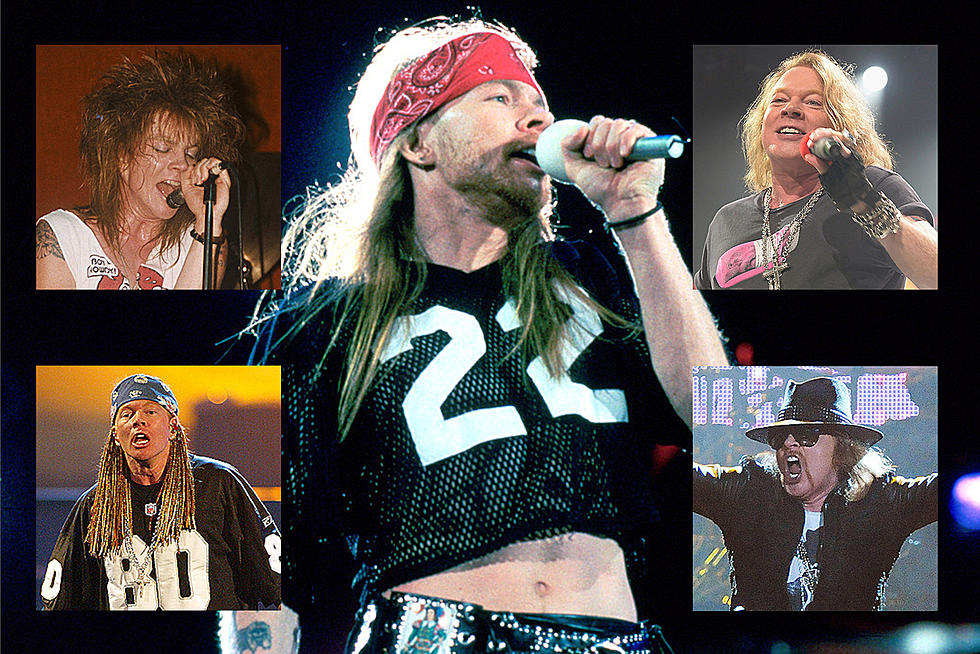
The History of Guns N’ Roses’ Controversy-Courting ‘Appetite for Destruction’ Cover
Guns N' Roses' breakthrough with Appetite for Destruction took longer than expected, partially because a string of retailers refused to carry the album. Blame a gruesome original cover image, based on a Robert Williams painting of the same name, that depicts the interruption of a robot rape by an avenging metal angel.
Even Williams could predict that the painting would stir controversy. "I suggested that they come over to my house and look through some slides and pick something [else] for the cover," Williams once told Revolver magazine, "because I knew they were gonna get in trouble with it."
And indeed they did. Guns N' Roses' record label, Geffen, quickly forced them to find a replacement. They eventually settled on a cross-and-skulls design by Billy White Jr. that became something of a band logo in the years to come. And so ended an early bit of controversy that could be traced to decades before the 1987 release of Appetite for Destruction.
Williams began his career as an apprentice for Ed "Big Daddy" Roth, a Los Angeles-based hot-rod enthusiast and artist whose character Rat Fink had become an underground sensation in the mid '60s. Typically showed behind the wheel of fire-breathing vehicles, this tongue-wagging, googly-eyed rodent found a home on everything from T-shirts and model cars to comic books and novelty albums.
Williams came into Roth's orbit purely by accident. He'd been directed toward the outlaw cartoonist by the manager of a local unemployment office, in a desperate move after Williams had struck out everywhere else. "They told me that the 'freak' that ran it was some guy called Big Daddy," Williams says in Malicious Resplendence: The Paintings of Robt. Williams. "I said, 'Wait a minute, would that be Ed Roth?' They said it was, and I said, 'Let me at it. I was born for this job.'"
By the time Roth closed his studio in 1970, Williams had become Big Daddy's art director. That led to a stint at Zap Comix with Robert Crumb, who had illustrated famous album covers for Janis Joplin, B.B. King and others. Toward the end of the decade, Williams began a series of paintings called Super Cartoons that included "Appetite for Destruction."
Watch News Coverage of the 'Appetite for Destruction' Controversy
Crumb was reportedly the model for the robot aggressor in the illustration, though with something resembling a bear trap for a mouth. In an interesting twist, the looming red guardian boasts a Rat Fink-like tongue. Beyond that, however, Williams denied there was any deeper message to be gleaned. The Super Cartoons, he notes in The Lowbrow Art of Robt. Williams, "were intended to have no more meaning than a picture on a cocktail napkin, and if they appear to some people to be no more than tightly rendered cartoons, well, those people are right."
There was one final twist in the saga of Guns N' Roses' debut album cover: Axl Rose initially wanted to use an image of the space shuttle Challenger explosion. After they were dissuaded from that idea, Rose later came across a postcard image of Williams' "Appetite for Destruction," which featured the title in small capital letters.
They didn't settle on the album's now-famous cover until the third try. Rose returned to an image he'd discussed with a friend – something that started out, in fact, as a sketch for a tattoo created with White, an art student in Long Beach, Calif., at the time.
“One day Axl called and asked if I could draw him a tattoo, after he’d seen a drawing I’d done on my cousin’s wall," White recalled in an interview with Culture Creature. “I said sure, and we talked. The cross and skulls that looked like the band was Axl’s idea. The rest was me. The knot work in the cross was a reference to Thin Lizzy, a band Axl and I both loved.”
An artist named Andy Engel did some final refinements on the piece before it was approved. Only later did White find out his drawing would go on the front of the world's bestselling debut album. “Axl called again and said [my design] was going to be on the cover of everything, because the Williams painting got rejected," White said. "I was okay with that."
Despite a final front-cover image switch, Appetite for Destruction stuck as the title, and Williams' original painting could be found inside.
20 Most Historic Guns N' Roses Concerts
More From 96.7 The River










